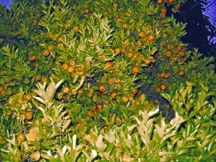Orange

Orange (kamala) common name of fruits belonging to the genus Citrus of family Rutaceae. Orange possibly originated in China, where the Chinese started planting it about four thousand years ago. There are many varieties of orange, some of which are either sweet or sour. The growing place of sour variety is North Europe. Columbus first planted the sweet variety in the USA. Orange now grows in countries like Japan, Spain, Brazil, India, Argentina, South Africa, Australia, Mexico, Italy, Greece and Morocco. In India it grows well in West Bengal, Tamil Nadu, Punjab, Assam, Orissa, Gujrat, Tripura, Andhrapradesh, and Meghalaya.

In Bangladesh orange is grown in some places of Sylhet, Chittagong Hill Tracts, Rangpur, and Panchagarh. The most commercially species important are the common or China orange, C. sineusis; the mandarine orange, C. reticulata, some varieties of which are known as tangerins; and the sour or Seville orange, C aurantium.
In 2005-06, total production of orange accounted for 1000 m.tons in Bangladesh. Orange plants are perennial medium-sized upright trees, which have lanceolate leaves with narrowly winged petiole. The plants are propagated vegetatively either by grafting or budding. Plants start bearing fruits after 4-5 years of planting. Flowers are borne singly or a few occur together in the leaf axils. Fruits are loose skinned, medium-sized and when ripe become orange coloured. Segments (8-10) are easily separable; the pulp is juicy and sweet. Each segment contains some pointed seeds, with light green cotyledons.
Fresh fruits, rich in Vitamin C, are preferred for consumption. Every 100g orange contains 0.93g protein, 0.3g fat, 11.02g carbohydrate, 0.4g mineral, 0.05g calcium, 0.02g' phosphorus, and 0.1g iron. Each kg of orange contains about 490 calorie of energy. Oranges are used in making jam, jelly, juice, squash, etc. Perfume is produced from the flowers, leaves and skin of orange. The bangladesh agricultural research institute (BARI) has recently released one variety named BARI Kamala Lebu 1. The fruit is nearly round, juicy and sweet. A matured plant may produce 300-400 fruits, and has an average weight of 190g. [SM Monowar Hossain and Md Mukbil Hossain]
